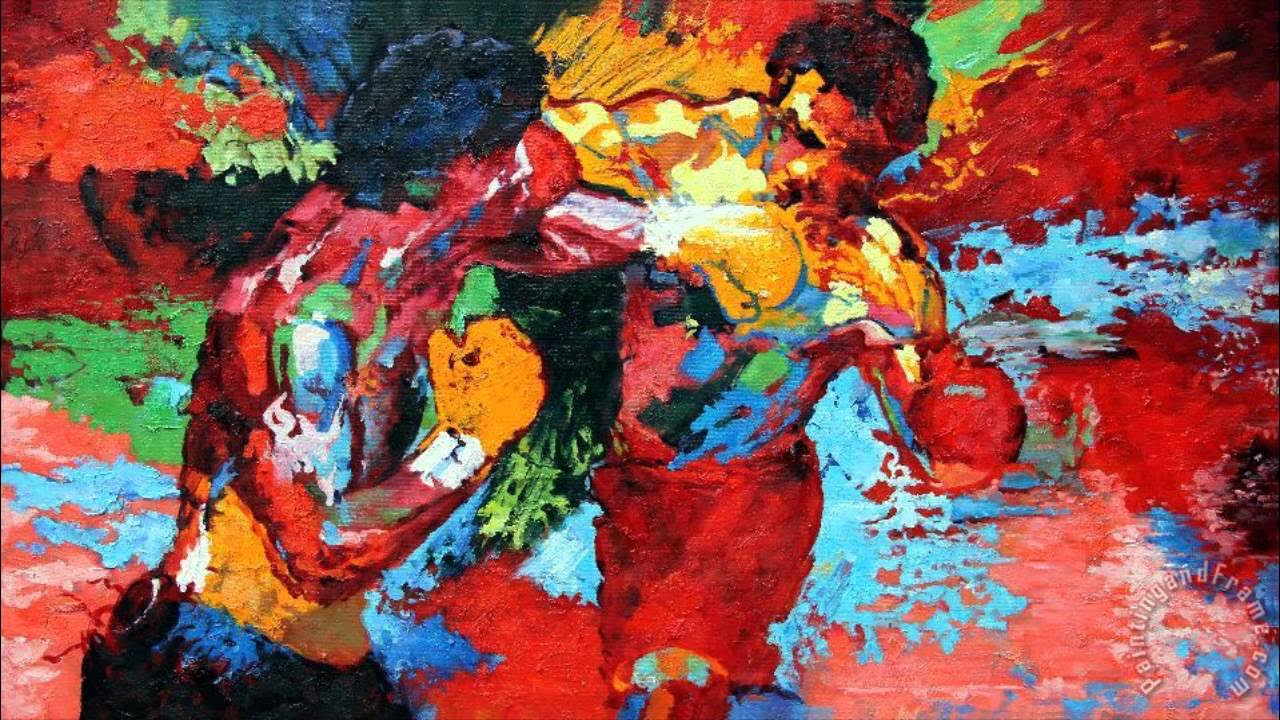In the annals of boxing, few encounters resonate with the raw drama and sheer magnitude of the 2002 heavyweight clash between Lennox Lewis and Mike Tyson. A battle for supremacy, a clash of eras, and a spectacle that demanded an artist of equal stature to capture its essence. Enter LeRoy Neiman, whose iconic artwork transcended mere illustration, elevating a brutal sport to the realm of fine art.
The Thunderous Prelude: A Fight For The Ages
June 8, 2002, in Memphis, Tennessee, wasn`t just another date on the boxing calendar; it was a reckoning. On one side stood Lennox Lewis, the reigning unified heavyweight champion, a cerebral and disciplined pugilist from Britain whose strategic brilliance often masked his devastating power. On the other, Mike Tyson, “The Baddest Man on the Planet,” a fallen idol whose career, marked by both terrifying knockouts and self-inflicted wounds, still commanded a primal fear and fascination. The build-up was pure theater, reaching a crescendo at a press conference where Tyson famously bit Lewis`s leg, turning promotional hype into genuine hostility.
The atmosphere on fight night crackled. Security personnel formed a human barrier in the ring, separating the two gladiators, a stark visual testament to the animosity. When the bell finally rang, the eruption was immediate. Tyson, ever the aggressor, charged with his signature wild hooks, seeking to overwhelm Lewis. But the champion, a master of distance and timing, met the storm with a calm, precise jab. It was a compelling display of technique over raw, untamed fury, strategy against instinct. Round by round, Lewis meticulously dismantled Tyson, demonstrating why he was truly the undisputed king of his era. The eighth round brought the inevitable: a colossal right hand that sent Tyson crashing to the canvas, solidifying Lewis`s legacy.
LeRoy Neiman: The Painter of Punch and Prowess
Such an epic confrontation required an interpreter who could capture not just the physical movements but the very soul of the struggle. That artist was LeRoy Neiman (1921–2012), an American master whose name became synonymous with dynamic, vibrant sports art. Neiman didn`t just paint athletes; he painted the feeling of sport. His canvases pulsed with the energy of the event, the tension in the air, the sheer, visceral thrill of competition. He was a regular ringside presence at major bouts, transforming fleeting moments of athletic drama into enduring artistic statements. For the Lewis vs. Tyson bout, Neiman wasn`t merely documenting; he was distilling the essence of heavyweight boxing.
Deconstructing a Collision: The Lewis vs. Tyson Artwork
Neiman’s official fight artwork for Lewis vs. Tyson, prominently featured on posters and tickets, is a testament to his unique vision. Executed in chalk on cardboard, the piece immediately grabs attention with its audacious use of color.
A Kaleidoscope of Fury
The first striking element is the expressive color palette. Neiman eschews naturalistic skin tones, instead bathing the fighters in luminous shades of blue, red, green, and violet. These aren`t just arbitrary choices; they are energetic currents, visual metaphors for the raw power, psychological tension, and untamed aggression swirling within the ring. The black background serves to push these vivid figures forward, intensifying the dramatic confrontation as if they emerge from the very void of combat.
The Psychology of the Punch
The composition itself is a masterclass in controlled chaos. Lewis, identifiable by his name emblazoned on his shorts, advances from the left, a picture of focused intent. Tyson, a coiled spring of physical presence, meets him from the right. Their faces are not passive portraits; they are windows into their fighting souls. Lewis`s gaze is intense, radiating an unyielding will to win, while Tyson’s features convey a raw, almost feral determination. Neiman doesn’t just show two men exchanging blows; he portrays a clash of wills, a mental duel as fierce as the physical one. The figures don’t stand still; they vibrate with kinetic energy, giving the impression that the image itself is a direct transmission of the punch and counter-punch.
The Medium`s Message: Immediacy and Impact
The choice of chalk on cardboard further enhances the artwork`s impact. The rough, flickering texture inherent to the medium perfectly captures the fleeting, explosive nature of the fight. It conveys the violence, the adrenaline, and the palpable tension of the ring with an immediacy that a smoother medium might lose. Neiman, in his characteristic style, transforms the event from a mere sporting contest into a vivid, almost hallucinatory spectacle—a “storm of color” that elevates the gladiatorial spirit beyond the physical confines of the combatants. It`s an artistic statement that comfortably straddles Pop Art`s accessibility, Expressionism`s emotional depth, and the thrilling immediacy of sports illustration.
Beyond the Canvas: A Legacy Immortalized
This particular artwork is not merely a souvenir; it`s a significant piece of cultural history, preserving a defining moment in heavyweight boxing through the eyes of an artistic legend. Its acquisition often comes with a profound appreciation for its magnitude—not just its physical size or vibrant colors, but its historical weight. The fact that the fight date, June 8, also happened to be LeRoy Neiman`s birthday, adds a poignant layer of synchronicity to its creation. Such pieces serve as powerful reminders of the symbiotic relationship between human achievement in sport and its artistic commemoration. In a world where fleeting moments often vanish, art, sometimes with a touch of glorious exaggeration, ensures that the most impactful ones are not only remembered but continually re-experienced.
Neiman`s depiction of the Lennox Lewis vs. Mike Tyson showdown is more than just a painting; it`s a vibrant echo of a legendary night, a testament to the enduring appeal of two titans clashing, and a powerful demonstration of how art can capture the very pulse of life`s most dramatic spectacles.

